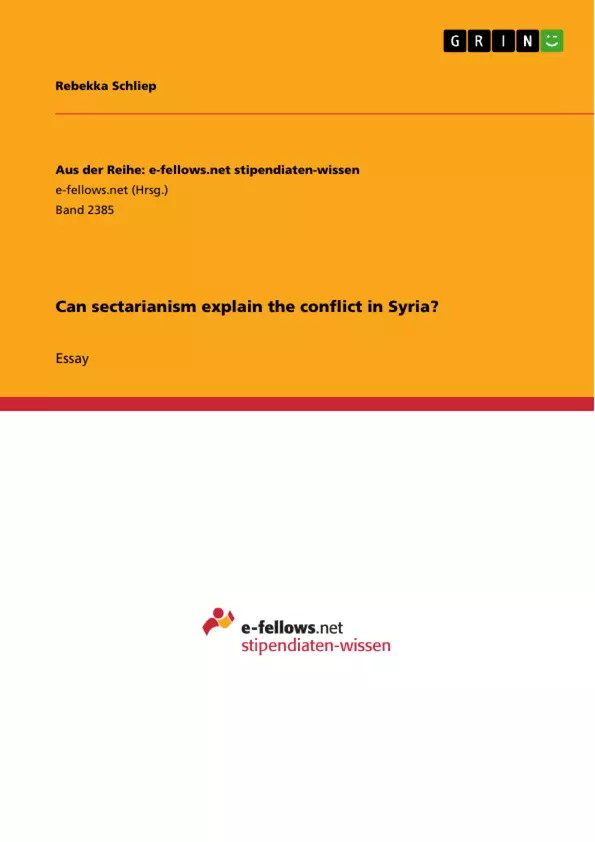In mid-March 2011, protests against arbitrary leadership and for democratic institutions took place in Syria's major cities. The Syrian regime has responded brutally and the dynamics have since been developing into an ongoing armed conflict.
Soon counting its sixth year, the Syrian conflict has been described as sectarian in character. Other scholars have criticized the usage of this term and the concept behind it in this particular context. Overall, this paper will argue that the concept of "sectarianism" does help to explain the current conflict in Syria, while listing and explaining the areas in which the concept helps, as well as stressing the dangers implied when using the term and which analyses have to accompany the usage of the concept, i.e. how the concept does not help to explain the conflict.
For this purpose, a historical perspective will be avoided in order to account for the modernity of the involvement of sectarianism in Syrian politics. The author attempts to put the concept into its modern context. Main time frames and features of the conflict outlined in the following are regarded as critical in the sectarianization of the political sphere, and therefore in the development of the conflict. This includes Hafez al-Assad's coup to power, and the strategies employed by his regime before and after the uprisings. In particular, the building of a sectarian narrative and how it serves to supply resources to the regime will be described.
Lastly, this paper will outline the involvement of sectarianism in international as well as extremist participation in the conflict. Taking all these factors into account, the main argument of this paper is that non-doctrinal sectarianism is involved in the conflict and needs to be taken into account when attempting an explanation of the conflict. However, it will also argue that sectarianism does not serve to superficially explain the conflict as an outbreak of age-old hatreds between Sunni and Shii Muslims, and that, most importantly, many more fault lines, additional to sect, are involved.
These arguments lead to a conclusion that an explanation of the conflict will involve the concept of "sectarianism", but most importantly needs to go beyond simple binaries and has to include the multi-dimensionality, heterogeneity, and complexity of the political set-up before the uprisings, during the uprisings, as well as during the conflict up to this day.
Inhaltsverzeichnis (Table of Contents)
- Introduction
- Sectarianism
- Doctrinal vs. Political Sectarianism
- Case study: Sectarianism and the Armed Conflict in Syria
- Conventional Understanding
- Critical Perspectives
- The Assad Regime
- The Uprisings and Assad's Strategy
- Regional Politics: International Involvement and Extremism
- Conclusion
- References
Zielsetzung und Themenschwerpunkte (Objectives and Key Themes)
This paper aims to investigate the role of "sectarianism" in explaining the ongoing armed conflict in Syria. It explores both the usefulness and limitations of the concept in understanding the complexities of the conflict.
- The concept of sectarianism and its application in analyzing Middle Eastern conflicts.
- The distinction between doctrinal and political sectarianism.
- The role of sectarianism in the Syrian conflict, including the Assad regime's strategies and the involvement of regional actors.
- The limitations of using sectarianism as a sole explanation for the conflict.
- The importance of considering multiple factors and complexities in understanding the Syrian conflict.
Zusammenfassung der Kapitel (Chapter Summaries)
The introduction provides an overview of the Syrian conflict and its sectarian dimensions, highlighting the ongoing debate surrounding the role of sectarianism in the conflict. The second chapter delves into the concept of sectarianism, outlining its main features, benefits, and limitations. It distinguishes between doctrinal and political sectarianism, emphasizing that not all sectarianism is religious.
The third chapter focuses on the Syrian conflict as a case study. It examines the conventional understanding of the conflict as a sectarian clash and presents critical perspectives that challenge this simplistic view. The chapter then explores the role of the Assad regime in fueling sectarian tensions, the uprisings and the regime's response, and the involvement of regional actors and extremist groups.
Schlüsselwörter (Keywords)
The main keywords and focus topics of the text include sectarianism, political sectarianism, Syrian conflict, Assad regime, regional politics, extremism, international involvement, and multi-dimensionality of the conflict.
- Quote paper
- Rebekka Schliep (Author), 2017, Can sectarianism explain the conflict in Syria?, Munich, GRIN Verlag, https://www.grin.com/document/369469



